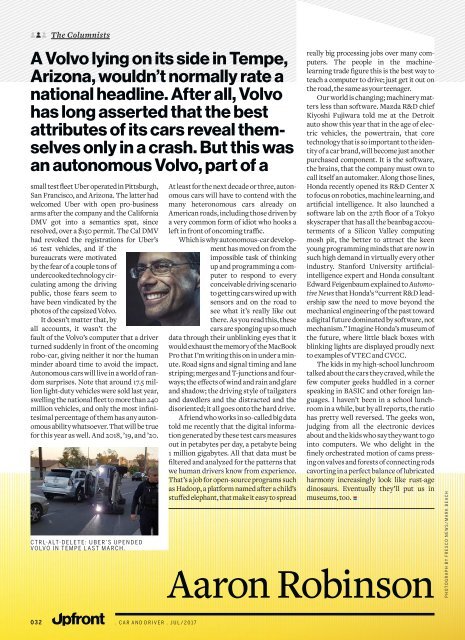Car_and_Driver_USA_July_2017
You also want an ePaper? Increase the reach of your titles
YUMPU automatically turns print PDFs into web optimized ePapers that Google loves.
The Columnists<br />
A Volvo lying on its side in Tempe,<br />
Arizona, wouldn’t normally rate a<br />
national headline. After all, Volvo<br />
has long asserted that the best<br />
attributes of its cars reveal themselves<br />
only in a crash. But this was<br />
an autonomous Volvo, part of a<br />
small test fleet Uber operated in Pittsburgh,<br />
San Francisco, <strong>and</strong> Arizona. The latter had<br />
welcomed Uber with open pro-business<br />
arms after the company <strong>and</strong> the California<br />
DMV got into a semantics spat, since<br />
resolved, over a $150 permit. The Cal DMV<br />
had revoked the registrations for Uber’s<br />
16 test vehicles, <strong>and</strong> if the<br />
bureaucrats were motivated<br />
by the fear of a couple tons of<br />
undercooked technology circulating<br />
among the driving<br />
public, those fears seem to<br />
have been vindicated by the<br />
photos of the capsized Volvo.<br />
It doesn’t matter that, by<br />
all accounts, it wasn’t the<br />
fault of the Volvo’s computer that a driver<br />
turned suddenly in front of the oncoming<br />
robo-car, giving neither it nor the human<br />
minder aboard time to avoid the impact.<br />
Autonomous cars will live in a world of r<strong>and</strong>om<br />
surprises. Note that around 17.5 million<br />
light-duty vehicles were sold last year,<br />
swelling the national fleet to more than 240<br />
million vehicles, <strong>and</strong> only the most infinitesimal<br />
percentage of them has any autonomous<br />
ability whatsoever. That will be true<br />
for this year as well. And 2018, ’19, <strong>and</strong> ’20.<br />
CTRL-ALT-DELETE: UBER’S UPENDED<br />
VOLVO IN TEMPE LAST MARCH.<br />
At least for the next decade or three, autonomous<br />
cars will have to contend with the<br />
many heteronomous cars already on<br />
American roads, including those driven by<br />
a very common form of idiot who hooks a<br />
left in front of oncoming traffc.<br />
Which is why autonomous-car development<br />
has moved on from the<br />
impossible task of thinking<br />
up <strong>and</strong> programming a computer<br />
to respond to every<br />
conceivable driving scenario<br />
to getting cars wired up with<br />
sensors <strong>and</strong> on the road to<br />
see what it’s really like out<br />
there. As you read this, these<br />
cars are sponging up so much<br />
data through their unblinking eyes that it<br />
would exhaust the memory of the MacBook<br />
Pro that I’m writing this on in under a minute.<br />
Road signs <strong>and</strong> signal timing <strong>and</strong> lane<br />
striping; merges <strong>and</strong> T-junctions <strong>and</strong> fourways;<br />
the effects of wind <strong>and</strong> rain <strong>and</strong> glare<br />
<strong>and</strong> shadow; the driving style of tailgaters<br />
<strong>and</strong> dawdlers <strong>and</strong> the distracted <strong>and</strong> the<br />
disoriented; it all goes onto the hard drive.<br />
A friend who works in so-called big data<br />
told me recently that the digital information<br />
generated by these test cars measures<br />
out in petabytes per day, a petabyte being<br />
1 million gigabytes. All that data must be<br />
filtered <strong>and</strong> analyzed for the patterns that<br />
we human drivers know from experience.<br />
That’s a job for open-source programs such<br />
as Hadoop, a platform named after a child’s<br />
stuffed elephant, that make it easy to spread<br />
really big processing jobs over many computers.<br />
The people in the machinelearning<br />
trade figure this is the best way to<br />
teach a computer to drive; just get it out on<br />
the road, the same as your teenager.<br />
Our world is changing; machinery matters<br />
less than software. Mazda R&D chief<br />
Kiyoshi Fujiwara told me at the Detroit<br />
auto show this year that in the age of electric<br />
vehicles, the powertrain, that core<br />
technology that is so important to the identity<br />
of a car br<strong>and</strong>, will become just another<br />
purchased component. It is the software,<br />
the brains, that the company must own to<br />
call itself an automaker. Along those lines,<br />
Honda recently opened its R&D Center X<br />
to focus on robotics, machine learning, <strong>and</strong><br />
artificial intelligence. It also launched a<br />
software lab on the 27th floor of a Tokyo<br />
skyscraper that has all the beanbag accouterments<br />
of a Silicon Valley computing<br />
mosh pit, the better to attract the keen<br />
young programming minds that are now in<br />
such high dem<strong>and</strong> in virtually every other<br />
industry. Stanford University artificialintelligence<br />
expert <strong>and</strong> Honda consultant<br />
Edward Feigenbaum explained to Automotive<br />
News that Honda’s “current R&D leadership<br />
saw the need to move beyond the<br />
mechanical engineering of the past toward<br />
a digital future dominated by software, not<br />
mechanism.” Imagine Honda’s museum of<br />
the future, where little black boxes with<br />
blinking lights are displayed proudly next<br />
to examples of VTEC <strong>and</strong> CVCC.<br />
The kids in my high-school lunchroom<br />
talked about the cars they craved, while the<br />
few computer geeks huddled in a corner<br />
speaking in BASIC <strong>and</strong> other foreign languages.<br />
I haven’t been in a school lunchroom<br />
in a while, but by all reports, the ratio<br />
has pretty well reversed. The geeks won,<br />
judging from all the electronic devices<br />
about <strong>and</strong> the kids who say they want to go<br />
into computers. We who delight in the<br />
finely orchestrated motion of cams pressing<br />
on valves <strong>and</strong> forests of connecting rods<br />
cavorting in a perfect balance of lubricated<br />
harmony increasingly look like rust-age<br />
dinosaurs. Eventually they’ll put us in<br />
museums, too.<br />
Aaron Robinson<br />
PHOTOGRAPH BY FRESCO NEWS/MARK BEACH<br />
032 . CAR AND DRIVER . JUL/<strong>2017</strong>


















